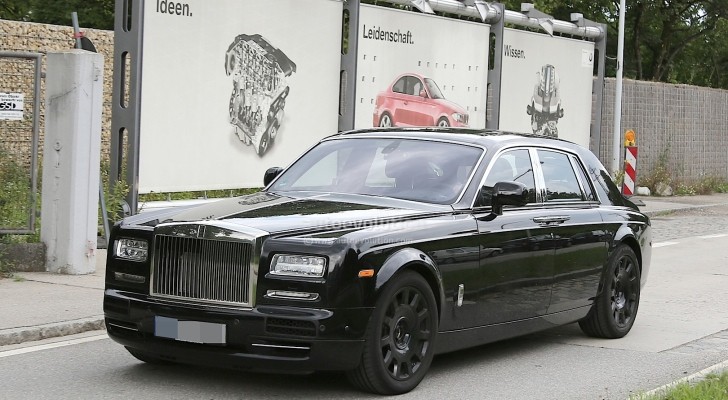Ladies and gentlemen chauffeurs, you are enjoying the first spyshots of the next-generation Rolls-Royce Phantom. A test mule (fresh technology hidden under the current body) was recently snapped while testing in the proximity of BMW’s Landshut technical center in Germany.
In typical RR manner, the Phantom received an overhaul back in 2012, but the vehicle has been with us since 2003, so the current development is only natural. We’ll have plenty of time to discuss this, since the new Phantom should be released in 2017 as a 2018 model.
There are multiple clues that give away the tech changes underneath the familiar sculpted metal, starting with the two new air intakes up front. Take a look at the rear end of the Phantom - usually, Rolls-Royce models cover the actual exhaust tips with faux chrome elements, but this was not necessary here.
While the intake and exhaust play suggest the presence of a new powerplant, the stories that run around the future Phantom’s engine bay are numerous.
Certain sources believe the Rolls will benefit from the tech advances brought by the next-gen BMW 7-Series’ V12. The Bavariasn are currently well into the development process of their future 7, whose V12 is know as N74B66U1 by engineers.Then again, this is expected to be derived from the V12 currently used by the Rolls-Royce Wraith, which, in turn, has a lot to do with the 7-Series unit.
And while Rolls-Royce is not all that convinced about an all-electric model after its customers were less than impressed with the Phantom 102EX electric vehicle concept, there should be a plug-in hybrid - after all, BMW is working on a complete range of such vehicles, while Bentley has confirmed it will offer a plug-in hybrid option in every future model. We'll remind you that while Rolls-Royce is still considering electric power, hybrid models should arrive within two years from now.
As for the platform, once again, the opinions on what the company is doing are split. Some claim the 2016 7-Series platform will once again be adapted for the Rolls-Royce badge. Others claim the British automaker will receive its dedicated architecture. This would use a carbon tub with aluminum subframes.
The latter version seems to make more sense, especially since Rolls-Royce will also most likely release an SUV - thus, developing a shared bespoke platform make financial sense.
Either way, the current model, which already uses an aluminum spaceframe, tips the scales at over 5,600 lbs (2,550 kg), so a diet would be welcome.
When it comes to the details of the cabin, obviously the most important side of such a vehicle, it may be way to early to tell, but we’ll remind you what Rolls-Royce told the New York Times back in the late 80s -“We don't want electronic display panels that light up like a video game. You don't need anything that squawks at you. We would consider it an intrusion upon the sensibility of the driver.''
Times have obviously changed, but we expect the intrument cluster to retain itsanalogue jewelry form.
There are multiple clues that give away the tech changes underneath the familiar sculpted metal, starting with the two new air intakes up front. Take a look at the rear end of the Phantom - usually, Rolls-Royce models cover the actual exhaust tips with faux chrome elements, but this was not necessary here.
While the intake and exhaust play suggest the presence of a new powerplant, the stories that run around the future Phantom’s engine bay are numerous.
Certain sources believe the Rolls will benefit from the tech advances brought by the next-gen BMW 7-Series’ V12. The Bavariasn are currently well into the development process of their future 7, whose V12 is know as N74B66U1 by engineers.Then again, this is expected to be derived from the V12 currently used by the Rolls-Royce Wraith, which, in turn, has a lot to do with the 7-Series unit.
And while Rolls-Royce is not all that convinced about an all-electric model after its customers were less than impressed with the Phantom 102EX electric vehicle concept, there should be a plug-in hybrid - after all, BMW is working on a complete range of such vehicles, while Bentley has confirmed it will offer a plug-in hybrid option in every future model. We'll remind you that while Rolls-Royce is still considering electric power, hybrid models should arrive within two years from now.
As for the platform, once again, the opinions on what the company is doing are split. Some claim the 2016 7-Series platform will once again be adapted for the Rolls-Royce badge. Others claim the British automaker will receive its dedicated architecture. This would use a carbon tub with aluminum subframes.
The latter version seems to make more sense, especially since Rolls-Royce will also most likely release an SUV - thus, developing a shared bespoke platform make financial sense.
Either way, the current model, which already uses an aluminum spaceframe, tips the scales at over 5,600 lbs (2,550 kg), so a diet would be welcome.
When it comes to the details of the cabin, obviously the most important side of such a vehicle, it may be way to early to tell, but we’ll remind you what Rolls-Royce told the New York Times back in the late 80s -“We don't want electronic display panels that light up like a video game. You don't need anything that squawks at you. We would consider it an intrusion upon the sensibility of the driver.''
Times have obviously changed, but we expect the intrument cluster to retain its







